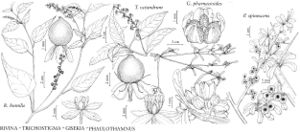Gisekia pharnacioides
Mant. Pl. 2: 562. 1771.
Plants prostrate to ascending or erect, 1.5–8 dm, glabrous. Leaves: petiole 0–1 cm, with a thin margin to winged; blade linear to oblanceolate-spatulate or elliptic, to 6 × 1.9 cm, white-flecked by bundles of raphides, base tapering, apex rounded to acute, sometimes minutely apiculate. Inflorescences congested to lax, 0.2–1.5 cm wide; peduncle 0.5 cm; pedicel 1–4 mm. Flowers: sepals pinkish to purplish, becoming greenish in age, ovate to oblong, 1–3 mm; filaments dilated at base; ovary distinct. Achenes muricate, 1–1.5 mm. 2n = 36.
Phenology: Flowering spring–fall.
Habitat: Sandy, disturbed soils, often in orchards
Elevation: 0-30 m
Distribution
Fla., Asia, Africa.
Discussion
Gisekia pharnacioides, a widespread weed in tropical and subtropical parts of southern Africa and southern Asia, was reported as introduced in Florida by R. K. Godfrey (1961). In habit and especially inflorescence type, the plant is decidedly unlike other members of the Phytolaccaceae in the flora area. It bears a superficial resemblance to Mollugo verticillata Linnaeus of the Aizoaceae.
In the flora, plants with achene sutures obscurely toothed are var. pharnacioides; plants with sutures frequently expanded into prominent whitish dorsiventral crests or wings are var. alata M. G. Gilbert, known from Arabia, Iran, and Pakistan (M. G. Gilbert 1993).
The specific epithet is sometimes misspelled “pharnaceoides.”
Selected References
None.
